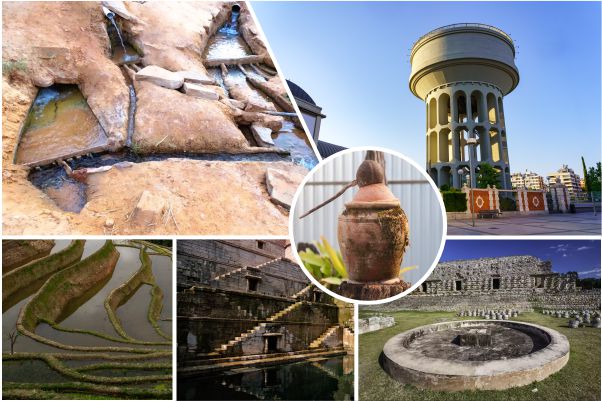
Water is the most important essence of life, and ancient cultures understand this better than anyone. Long before the advent of modern plumbing and water systems, historical civilizations developed creative techniques to collect, store, and use rainwater. These age-old practices not only helped them survive but also inspired modern water conservation techniques.
Let’s explore how these resourceful cultures used the power of rainwater for their needs.
Why Was Rainwater Harvesting Important for Ancient Civilization?
Water shortage/scarcity isn’t just a modern problem, ancient civilizations often lived in dry regions or faced seasonal rainfall. Rainwater harvesting become a necessity to ensure a reliable supply for drinking water, agriculture, and daily activities. Via storing rainwater, these cultures validated foresight and innovation that remains relevant nowadays.
1. Ancient India: The settler of Rainwater Harvesting

India has a history of water conservation. Ancient Indians developed structures called stepwells and kunds to collect and store rainwater.
- Stepwells: These were deep wells with steps leading down to the water. Built in regions like Rajasthan and Gujrat, they not only stored water but also cultural gatherings.
- Kunds: Kunds were small, dome-shaped tanks that collected rainwater from rooftops and open areas. Found primarily in dry areas, kunds ensured a year-round water deliver.
- Tanks and Lakes: Kings and neighbourhood rulers constructed large water storage tanks and lakes to store monsoon rainwater, like the famous Lake in Rajasthan.
The Indian ingenuity lay in blending utility with spirituality, as many of these water structures were also considered sacred.
2. The Romans: Masters of Aqueducts and Cisterns

The Romans were architectural geniuses, and their water management systems were no exception. They constructed waterways to move water from distant sources and used cisterns to shop rainwater.
- Cisterns: Romans built underground storage tanks lined with cement to hold rainwater. Some of these cisterns were so large they could supply water to entire towns.
- Rooftop Collection: Rainwater was channeled from rooftops into cisterns or terracotta pots, ensuring no drop was wasted.
- Public Baths and Fountains: These were supplied by stored rainwater, showcasing their emphasis on each utility and luxury.
The Roman approach to water management was a mix of performance and grandeur, leaving a legacy that inspires modern engineering.
3. The Mayans: Innovators of Chultuns

The Mayan civilization in Central America thrived in regions with limited natural water sources. Their answer? The ancient Maya were innovators of Chultuns, which were bottle-shaped underground chambers used for storing water, food, and other items.
- Design: Chultuns are bottle-shaped structures with narrow openings and wider bases to minimize evaporation.
- Lining: The interiors were coated with plaster to make them waterproof.
- Community Storage: These were often located near villages, serving as communal water storage.
The Mayans’ ability to adapt to their difficult environment is a testament to their resourcefulness.
4. Ancient China: Terrace Farming and Water Supplies

China’s historical water management practices were revolutionary. They combined rainwater harvesting with agriculture to maximize efficiency.
- Terrace Farming: In mountainous regions, were designed to capture rainwater, preventing soil erosion and ensuring crops received good enough moisture.
- Water Reservoirs: The Chinese language constructed reservoirs just like the famous Dujiangyan Irrigation system to store and distribute water for agriculture.
- Pond Systems: Small ponds were constructed near villages to collect and store rainwater for domestic use.
Their innovative use of geography and engineering made them pioneers in sustainable water practices.
5. Middle East: The Genius of Qanats and Cisterns

In the dusty landscapes of the Middle East, civilization like the Persians developed systems to store and transport rainwater.
- Qanats: Qanats are underground channels that deliver water from underground sources to the floor for irrigation and home use. they’re additionally called karez or okāriz.
- Rock Cisterns: Rock cisterns are underground water reservoirs carved into rock to store rainwater. They were utilized in ancient times to provide water at some point of during dry seasons. In areas like Jordan, rainwater was stored in rock-cut cisterns, some of which are still in use today.
- Urban Storage: Ancient cities like Petra had elaborate systems of reservoirs and channels to harvest rainwater, sustaining huge population in harsh conditions.
The Middle Eastern strategies showcased how innovation could overcome even the most challenging environments.
6. Africa: Sacred Groves and Water Pits

Sacred groves in Africa are traditional sites which can be covered via nearby cultures and religions. They are regularly related to animist traditions and are observed for the duration of tropical Africa.
- Water Pits: In areas like Ethiopia, farmers dug pits to collect and store rainwater for agriculture.
- Sacred Groves: Trees were planted around water collection regions to prevent evaporation and soil erosion.
- Rock Catchments: In Kenya, natural rock formations were modified to gather rainwater, growing a sustainable source of water.
These practices often blended with local traditions, ensuring water conservation remained a community effort.
7. Native Americans: Natural and Sustainable Practices

Native American tribes in North America used natural substances and landscapes to harvest and store rainwater.
- Clay Pots: Rainwater was changed into collected in clay pots, which had been smooth to make and delivery.
- Terracing: Just like Chinese, they used terraced fields to seize rainwater for agriculture.
- Rain Gardens: Depressions in the ground were used to collect rainwater, which helped in recharging the groundwater.
Their eco-friendly practices are a reminder of the importance of living in harmony with nature.
Lessons from the Past for the Future
The ancient strategies of rainwater harvesting weren’t just about survival; they were about sustainability and admiration for nature. Here are some lessons we can apply for today.
- Maximize Local Resources: Using natural geography and locally available materials for water storage reduces environmental impact.
- Design for Efficiency: Ancient storage structures minimized evaporation and ensured water stayed clean, principles that are still relevant today.
- Community Involvement: Many ancient practices were community-driven, highlighting the importance of collective responsibility in water conservation.
- Blend Tradition with Modernity: By combining traditional strategies with modern-day technology, we can create innovative solutions to address today’s water challenges.
Conclusion
Ancient cultures displayed incredible creativity in storing and managing rainwater, setting an example for sustainable water practices. Their techniques, even though developed centuries ago, are still relevant in addressing modern water scarcity issues. As we face increasing water challenges, trying to the past can offer valuable insights for the future.
Let’s celebrate and learn from the wisdom of ancient civilizations to ensure a sustainable and water-secure world for generations to come!
“Ancient wisdom for modern solutions: Harvesting every drop, saving every life.”
